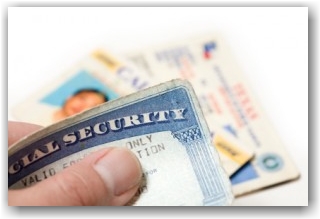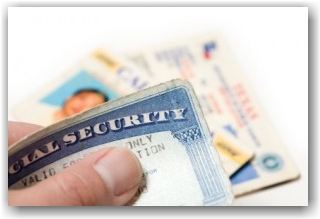Posts Tagged ‘SSA’
Monday, August 24th, 2015
The new rule provides SSA and the public with different options for verifying an applicant’s identity and other eligibility factors, noting that it will continue to require the same evidence to establish citizenship, age and identity. The new rule will also remove the requirement that individuals seeking a replacement SSN card file an SS-5 form, allowing them instead to complete a “prescribed application,” which the agency said would simply be the application form — whether paper, online or another efficient, user friendly method. Additionally, the SSA will release, through a gradual, state-by-state rollout, an online application that will permit adult U.S. citizens who are not reporting any changes to their record to apply for replacement SSN cards electronically after registering through the “my Social Security” portal.
How will this change procedures for processing the I-9 Employment Eligibility Verification Form? The article states that employers are likely to find more rapid turnaround should employees lack a lost or misplaced social security card requiring reissuance. USCIS Form I-9 permits employers to initiate employment, in most instances, if hired employees can verify within three (3) days employment eligibility through the documentary requirements of USCIS Form I-9, including presentation of a valid social security card under “List C” of Form I-9.
::::::::
Immigration Compliance Group provides US inbound visa services to individuals and employers throughout the USA and abroad. We specialize in business immigration and have a depth of experience in the IT, healthcare, arts, entertainment and sports industries, amongst others. Our services include complex business visas for investors, multinational managers, skilled professionals, outstanding individuals of high achievement and PERM Labor Certification. We additionally provide employer compliance consulting services on proper I-9 (Employment Eligibility Verification) management, auditing, training, and work with our clients to develop a culture of immigration compliance.
Tags: Employer Compliance, Employment Verification, I-9 AUDIT, I-9 Form, I-9/E-Verify News, ICE, Legal Workforce, Social Security Card, SSA, USCIS
Posted in DACA | DAPA, Employer Compliance, I-9/E-Verify News, Social Security, USCIS | Comments Off on New Social Security Card Process to Commence Sept 9, 2015
Sunday, January 5th, 2014
 DHS/ICE continues to issue Notices of Intent to Fine (NOFs) at an unprecedented rate for Form I-9 related infractions. Mistakes occur in the I-9 process, it’s inevitable. While establishing a written compliance policy, training and careful prevention is the best approach. All employers should take time at the beginning of each year to conduct an internal audit and self-examination of their systems, operating procedures, and past and present practices for handling I-9s, as well as to access training needs for the employees charged with handling and supervising the I-9 process. We also recommend that you review your E-Verify submissions, as well as revisiting just how compliant your I-9 software really is with your vendor if you are using an electronic system.
DHS/ICE continues to issue Notices of Intent to Fine (NOFs) at an unprecedented rate for Form I-9 related infractions. Mistakes occur in the I-9 process, it’s inevitable. While establishing a written compliance policy, training and careful prevention is the best approach. All employers should take time at the beginning of each year to conduct an internal audit and self-examination of their systems, operating procedures, and past and present practices for handling I-9s, as well as to access training needs for the employees charged with handling and supervising the I-9 process. We also recommend that you review your E-Verify submissions, as well as revisiting just how compliant your I-9 software really is with your vendor if you are using an electronic system.
While there are many checklists and do-it-yourself guides and webinars available on the Internet and elsewhere, consulting a licensed attorney or specialist in the field who is familiar with I-9 and E-Verify compliance issues can save employers hours of research, provide a solution tailored to your organization, and save you thousands of dollars in fines and penalties should ICE knock on your door.
When ICE notifies an employer of their intention to perform an audit, it opens the door for an onslaught of inquiries and investigation from other government agencies that range from SSA mis-match issues to Department of Labor (DOL) wage and hour, USCIS, IRS, and more if you have areas of incompliance in your operating procedures. This is not the time during an audit when under pressure to clean up compliance problems.
New employers are often more at risk because many are not even aware of the I-9 requirement, and probably are also unaware of the need for all employees to complete the I-9 Form. Some are aware, but they lack knowledge concerning the regulations that govern the form; such as, timeframes, acceptable documents, form retention, and other important details that are integral to the process. Particularly, there are problems with industries such as IT consulting, healthcare, staffing agencies, and other organizations with multiple locations in regard to completing the I-9-Form remotely with the employer’s designated agent and employee in different locations.
These are just a few reasons why we urge you to assess the strengths and weaknesses of your present compliance program, and start the New Year fresh with a renewed commitment to implement best practices that will provide the foundation upon which you can develop and maintain a more compliant business and workforce.
You might be interested in joining our LinkedIn group, I-9/E-Verify: Smart Solutions for Employers,” and signing up to receive via RSS feed or email our Blog posts.
Tags: +, Department Of Homeland Security (DHS), DOL, E-Verify, I-9 AUDIT, I-9 Best Practices, I-9 Comipliance, I-9 Form, I-9 Training, I-9/E-Verify News, ICE, Immigration News, Legal Workforce, OSC, SSA
Posted in Department Of Homeland Security (DHS), Department Of Labor (DOL), Employer Compliance, Healthcare, I-9/E-Verify News, ICE, Immigration News, OSC, Social Security, Staffing Agencies, USCIS | Comments Off on Compliance Audits are Recommended for Employers at the Beginning of the New Year
Friday, November 29th, 2013
 On December 8, 2013 E-Verify will release new and revised Memorandums of Understanding (MOUs) that are tailored to each access method.
On December 8, 2013 E-Verify will release new and revised Memorandums of Understanding (MOUs) that are tailored to each access method.
The changes were made in response to customer feedback and to update the MOUs with policy and process changes. Users will find that the new versions have more plain language and are easier to understand, with new titles that clearly identify the access method to which the MOU applies, and bullets that have been changed to letters and numbers to make searching and citation easier. Also, the lengthy sections have been broken up.
Please take the time to review and become familiar with the new MOU’s that apply to your access method; refer to the Fact Sheet and the preview of the new MOUs here. You can also access this information under “View Essential Resources” by logging into E-Verify to review the new and revised MOUs.
What you need to know
- Current E-Verify users will not be required to execute a new MOU, but are bound by any and all enhancements to the E-Verify program including the new or revised MOUs that apply to their access method. Current users should become familiar with the new or revised MOU that applies to them. The effective date of the MOU for existing users is January 8, 2014.
- The E-Verify enrollment process has not changed. New Users will review and execute the new or revised version of the MOU that applies to their access method during enrollment. The effective date of the MOU for new users is December 8, 2013.
- The new and revised MOUs include several updated provisions such as enhanced privacy protections and instructions for reporting privacy and security breaches.
Revised Memorandums of Understanding
TeleConferences
Two teleconferences will be hosted by USCIS to introduce and discuss the revisions schedule as follows:
1) For General Audience: December 11(Wed.) 2:30 – 3:30 EST. Will discuss the revisions made to the existing MOU’s and will open up for Questions. Register here
2) For E-Verify Users: December 12 (Thurs.), 2:30 – 3:30 EST. USCIS officials will provide an overview of the three new MOUs for Web service participants, and be available to answer questions. Register here
If you have any questions regarding the registration process, or if you have not received confirmation email within two business days, please email us at Public.Engagement@uscis.dhs.gov.
Tags: Department Of Homeland Security (DHS), E-Verify, E-Verify MOU, Employment Eligibility Verification, I-9 Form, I-9/E-Verify News, I-9/E-Verify News, ICE, Immigration News, Legal Workforce, SSA, USCIS
Posted in Employer Compliance, I-9/E-Verify News, ICE, Immigration News, Social Security, USCIS | Comments Off on E-Verify Update —–New/Revised MOU’s Released
Monday, November 11th, 2013

While DHS/ICE continues to issue Notices of Intent to Fine (NOFs) at an unprecedented rate for Form I-9 related infractions, this is yet another reminder that you can choose to pay the fine or you can contest the fine and file for a hearing (within 30 days of receipt of the NOF) before an Administrative Law Judge (ALJ) who handles cases related to employer sanctions, document fraud and unfair immigration-related employment practices. OCAHO has more than proven that they are willing to reassess and lower fees in just about every case in recent months.
Note that many employer sanctions cases never proceed to the hearing stage because either the parties reach a settlement with the approval of the ALJ, or the ALJ resolves a case through a prehearing ruling.
We recommend that your first step in the process be to retain experienced representation that specializes in the practice area of employer compliance to guide you step by step through the process – don’t attempt to go this alone. The next step is to understand the process that has been summarized very efficiently in the recent Fact Sheet that we refer to here
Should you have any questions or wish to become a client of our office, please contact us or refer to our services & solutions page.
Tags: ALJ I-9 Hearing, Department Of Homeland Security (DHS), Document Fraud, DOL, Employer Sanctions, I-9 Fees, I-9 Form, I-9/E-Verify News, ICE Audit, ICE Investigation, Immigration News, IRCA, Legal Workforce, Notice of Intent to Fine, OCAHO, OSC, SSA
Posted in DOJ, Employer Compliance, Federal Contractors, I-9/E-Verify News, ICE, Immigration News, OSC, Social Security | Comments Off on How to Contest an I-9 Notice of Intent to Fine (NOF)
Thursday, October 31st, 2013

Infosys is India’s second largest software exporter, and has about 30,000 workers in the U.S. (160,000 worldwide) with $6B in sales.
After years of investigation, it was found that Infosys “knowingly and unlawfully” brought Indian workers into the United States on B-1 business visitor visas( since 2008), to circumvent the higher costs and delays of a longer-term employment-related visa, such as the H-1B visa that the workers should have had. It was found that Infosys systematically submitted misleading information to US immigration authorities and consular officials to obtain the B-1 visas that do not permit employment, unfairly gaining a competitive edge and undercutting American workers qualified for the jobs
Press release states: “Infosys failed to maintain I-9 records for many of its foreign nationals in the United States in 2010 and 2011 as required by law, including a widespread failure to update and re-verify the employment authorization status of a large percentage of its foreign national employees…more than 80 percent of Infosys’s I-9 forms for 2010 and 2011 contained substantive violations.”
The largest fine of its kind, was paid out as follows: $5 million to Homeland Security Investigations, $5 million to the Department of State, and $24 million to the DOJ.
How can employers protect themselves?
The five federal agencies charged with workplace enforcement are not only going after businesses that are known to employ undocumented workers, but they are also making examples out of industry leaders across the country creating headline news. It goes without saying, that this is now a topic that should be on HR executives’ action list. Turning a blind eye can be exceedingly costly and cause great damage to a company’s reputation.
For more on this Story: CBS Reports NY Times
For more on our services and solutions
Tags: B-1 Visa, Business Immigration, DOL, H-1B Visa, HSI, I-9 Violations, I-9/E-Verify News, ICE Audit, ICE Investigation, ICE NOI, Indian IT Industry, Infosys, Legal Workforce, Skilled Professionals, Specialty Workers, SSA, US Consulates, USCIS, Visa Fraud
Posted in Department Of Homeland Security (DHS), Department Of Labor (DOL), Department of State, Employer Compliance, H-1B Visas, I-9/E-Verify News, ICE, Immigration News, Social Security, USCIS | Comments Off on Infosys to pay $34M in Fines for Visa Fraud and I-9 Violations
Thursday, October 24th, 2013
 We have written many articles over the years on what happens when ICE serves an employer with a Notice of Inspection (NOI); see below for links to our articles and resources. Today, ICE released a new Fact Sheet that referrences the IRCA law in the 1st paragraph, and then summarizes the order in which an ICE administrative inspection proceeds, the types of notices that are issued following an I-9 ICE audit, how fines are determined based upon knowingly hiring and continuing to employ violations, to substantive and uncorrected techical violations, and how these fines and penalties are calculated.
We have written many articles over the years on what happens when ICE serves an employer with a Notice of Inspection (NOI); see below for links to our articles and resources. Today, ICE released a new Fact Sheet that referrences the IRCA law in the 1st paragraph, and then summarizes the order in which an ICE administrative inspection proceeds, the types of notices that are issued following an I-9 ICE audit, how fines are determined based upon knowingly hiring and continuing to employ violations, to substantive and uncorrected techical violations, and how these fines and penalties are calculated.
The penalties for ignoring the legal requirements of the I-9 process can be quite severe, even in cases of unintentional omissions and uncorrected I-9 mistakes. Civil penalties for such errors may range from $110 to $1,100 for each effected employee. A business with thousands of employees and multiple worksites may face a significant financial burden in noncompliance penalties. The fines may be further increased if ICE determines that an employer knowingly hired unauthorized foreign nationals, and can range from $375 to $16,000 per violation with repeat offenders on the high end. Employers and their representatives convicted of having engaged in a pattern or practice of knowingly hiring unauthorized foreign nationals, may also face criminal charges and fines of up to $3,000 per employee and/or six months’ imprisonment. Other federal criminal statues may provide higher penalties in certain fraud cases.
Employers and individuals who commit citizenship status or national origin discrimination may be ordered to pay civil fines and attorneys’ fees. The penalties range from $375 to $3,200 for the first offense for each individual discriminated against; from $3,200 to $6,500 for the second offense; and for subsequent offenses, not less than $4,300 and not more than $16,000 for each person effected.
The trend toward increased scrutiny of immigration employment practices will likely continue in the foreseeable future. With immigration reform still uncertain, ICE continues to step up enforcement activities with a deluge of NOI’s to employers every few months. These recent developments have made it even more critical that employers maintain a strong immigration compliance profile. Employers can no longer afford to think that because they don’t hire foreign nationals, they don’t have any I-9 issues or need to comply with I-9 immigration regulations.
The key to I-9 compliance for most organizations starts with a thorough self-examination of existing paper I-9’s, E-Verify submissions (if applicable), standard operating procedures, and past practices. While there are many checklists and do-it-yourself guides, free webinars and Podcasts available on the Internet and elsewhere, consulting an experienced immigration consultant or attorney in the practice area can save employers hours of research, provide a solution tailored to your organization and save you thousands of dollars in fines and penalties.
You should strongly consider an independent I-9 audit if…
- You’ve had a turnover in the HR position(s) charged with the responsibility of handling and processing I-9 Forms
- None of the staff charged with the I-9 process has been formally trained
- You already know that you have I-9 document violations, errors and unintentional mistakes
- You have recently gone through a corporate reorganization, merger or acquisition
- You know you have an on-boarding process that is complex, such as multiple jobsite locations where the I-9 process takes place
- When you haven’t documented your I-9 Form policies and procedures in a policy statement or procedures manual
- If you have a large volume of foreign worker I-9 forms
- If you do not have a calendar system for re-verification or terminated employee retention
- If you do not have a centralized I-9 recordkeeping process
- If you are photocopying documents presented during the I-9 process for some and not for others
- You participate in government contracts and have been asked to perform an I-9 audit
- You have not performed a random or full audit within the last year by either an internal individual who is familiar with I-9 compliance rules but does not deal with I-9s on a regular basis, or by a reputable independent I-9 auditor.
- You’ve never performed a self-audit or had any outside provider perform an I-9 audit
- You do not know how to make corrections to the I-9 form
- You’ve received SSA No Match Letters
- Your industry is being targeted by ICE
- You’re unaware that a new I-9 form was released and do not have a process in place for staying current with regulations and procedures
Immigration Compliance Group regularly represents clients from all industries to develop effective I-9 policies and compliance programs. By establishing and maintaining effective corporate policies and procedures, many of the above-mentioned warning signs can be addressed proactively in an audit before the government does one for you.
New ICE Fact Sheet
I-9Audit.com – Our Employer Resource Center Articles
Tags: Department Of Homeland Security (DHS), I-9 AUDIT, I-9 Compliance, I-9 News, I-9 Training, I-9/E-Verify, I-9/E-Verify News, ICE, ICE Audit, ICE Fines, ICE Inspection Fact Sheet, ICE Penalties, Immigration News, Legal Workforce, NOI, Notice of Inspection, OSC, SSA
Posted in Department Of Homeland Security (DHS), Employer Compliance, Federal Contractors, I-9/E-Verify News, ICE, Immigration News, OSC, Social Security | Comments Off on ICE Releases New Fact Sheet on the I-9 Inspection Process
Thursday, October 17th, 2013
E-Verify has resumed operations following the federal government shutdown. All E-Verify features and services are now available.
The following information addresses questions on how the federal government’s shutdown affected E-Verify and Form I-9.
Information For Employers
Form I-9
The Form I-9 requirements were not affected during the federal government shutdown. All employers must complete and retain a Form I-9 for every person hired to work for pay in the United States during the shutdown.
E-Verify
Employees who received a Tentative Nonconfirmation (TNC)
If an employee had a TNC referred between September 17, 2013 and September 30, 2013 and was not able to resolve the TNC due to the federal government shutdown, add 12 federal business days to the date printed on the ‘Referral Letter’ or ‘Referral Date Confirmation.’ Employees have until this new date to contact the Social Security Administration (SSA) or the Department of Homeland Security (DHS) to resolve their cases. If you have an employee who decided to contest his or her TNC while E-Verify was unavailable, you should now initiate the referral process in E-Verify. Employers may not take any adverse action against an employee because of a TNC.
Employees who received a SSA Final Nonconfirmation (FNC) or DHS No Show result
If an employee received a Final Nonconfirmation (FNC) or No Show because of the federal government shutdown, please close the case and select “The employee continues to work for the employer after receiving a Final Nonconfirmation result,” or “The employee continues to work for the employer after receiving a No Show result.” The employer must then enter a new case in E-Verify for that employee. These steps are necessary to ensure the employee is afforded the opportunity to timely contest and resolve the Tentative Nonconfirmation (TNC) that led to the FNC result.
Creating Cases: Three-Day Rule
You must create an E-Verify case for each employee hired during or otherwise affected by the shutdown by November 5, 2013. If you are prompted to provide a reason why the case is late (i.e., does not conform to the three-day rule), select ‘Other’ from the drop-down list of reasons and enter ‘federal government shutdown’ in the field. Federal Contractor
Deadlines
During the federal government shutdown, federal contractors could not enroll or use E-Verify as required by the federal contractor rule. If your organization missed a deadline because E-Verify was unavailable or if it has an upcoming deadline for complying with the federal contractor rule, please follow the instructions above and notify your contracting officer of these instructions.
Information For Employees
If the federal government shutdown prevented you from contesting a Tentative Nonconfirmation (TNC), you will be allowed additional time to contact the Social Security Administration (SSA) or Department of Homeland Security (DHS). If your TNC was referred between September 17, 2013 and September 30, 2013, and you were not able to resolve the mismatch due to the federal government shutdown, you should:
- Add 12 federal business days to the date printed on the ‘Referral Letter’ or ‘Referral Date Confirmation’ that your employer provided you after you contested the TNC. Federal business days are Monday through Friday and do not include federal holidays.
- Contact SSA or DHS by the new date to resolve your TNC.
If you received a Final Non-Confirmation (FNC) because you could not contact DHS or SSA during the federal government shutdown, or because you could not contact DHS or SSA in the first ten days after the government reopened, please contact your employer and request that the employer re-enter your query. For more information about contesting your TNC or FNC, please refer to Employee section of the E-Verify website.
Customer Support
E-Verify Customer Support expects an increase in requests for assistance. Due to this increase, customers may experience longer than normal delays and response times. We apologize for any inconvenience and appreciate your patience. For any questions or additional information about how the federal shutdown affects E-Verify, please email E-Verify@dhs.gov. For questions about Form I-9, please visit I-9 Central or email I-9Central@dhs.gov. Employers and employees may also contact E-Verify at 888-464-4218. Customer Support representatives are available Monday through Friday 8:00 am to 5:00 pm local time.
If you would like to become a client of our office or have any questions psertaining to this blog post, please give us a call.
Tags: DOL, E-Verify, E-Verify after Shutdown, Employment Eligiblity Verification, FNC, I-9, I-9/E-Verify News, Legal Workforce, OSC, SSA, TNC, USCIS
Posted in Employer Compliance, I-9/E-Verify News, ICE, Immigration News, OSC, Social Security, USCIS | Comments Off on E-Verify Now Open and Provides Instructions on Shutdown Issues for New Hires, TNCs and FNCs
Thursday, October 10th, 2013

On June 15, 2012, President Obama signed a memo calling for deferred action for certain undocumented young people who came to the U.S. as children and have pursued education or military service here. Applications under the program which is called Deferred Action for Childhood Arrivals (“DACA”) began on August 15, 2012. Individuals that meet particular criteria, are awarded employment authorization (a/k/a an “EAD Card”) by USCIS.
USCIS does not alert employers when EAD cards have been issued to existing employees, and the employee is under no obligation to present the document to the employer. However, should they do so, the employer is obligated to examine the document.
The Attached Fact Sheet identifies the employer’s obligations during the Form I-9 process and provides specific guidance to employers on the treatment of EADs issued by USCIS to DACA recipients, whether they be current employees who come forward on their own, or new hires.
Note that DACA guidance does not direct employers to perform E-Verify queries on current employees who present DACA work authorization. Rather, it states that employers should complete a new Form I-9 and perform an E-Verify query in certain situations involving material changes to identity information. More on this topic can be found in the new M-274 Handbook on pages 23-24.
Should you like to become a client of our office or have particular questions pertaining to this topic, please feel free to contact us.
Tags: DACA, DACA EAD Cards, DACA Fact Sheet, DOL, E-Verify, EAD Employment Authorization, I-9 AUDIT, I-9 Form, I-9 Reverification, I-9 Training, I-9/E-Verify News, ICE, Immigration News, Legal Workforce, M-274, OSC, SSA, USCIS
Posted in DACA | DAPA, Department Of Homeland Security (DHS), Department Of Labor (DOL), Employer Compliance, I-9/E-Verify News, ICE, Immigration News, OSC, Social Security | Comments Off on Form I-9 Processing for DACA Recipients
Sunday, October 6th, 2013
 The Immigration and Nationality Act (“INA”) prohibits employers from discriminating against individuals based on their citizenship or immigration status, or based on their national origin, in the Form I-9 process. It is important for employers to develop, implement and enforce anti-discrimination policies, practices and procedures, and to ensure that all employees conducting Form I-9 verification or E-Verify confirmation understand all program rules. Employers should also provide appropriate and adequate employee education on employer responsibilities and worker rights.
The Immigration and Nationality Act (“INA”) prohibits employers from discriminating against individuals based on their citizenship or immigration status, or based on their national origin, in the Form I-9 process. It is important for employers to develop, implement and enforce anti-discrimination policies, practices and procedures, and to ensure that all employees conducting Form I-9 verification or E-Verify confirmation understand all program rules. Employers should also provide appropriate and adequate employee education on employer responsibilities and worker rights.
To prevent discrimination, employer’s should treat all people equally when
- announcing a job
- taking applications
- performing interviews
- making job offers
- verifying the individual’s authorization to work
- hiring the individual
- terminating the individual’s employment
Employers also must not retaliate against a person who
- files a charge of discrimination with OSC or EEOC
- participates in an investigation or prosecution of a discrimination complaint
- asserts his or her rights or the rights of another person under anti-discrimination laws
The Department of Justice’s Office of Special Counsel for Immigration-Related Unfair Employment Practices (OSC) investigates charges of employment discrimination related to an individual’s citizenship or immigration status or national origin. The Equal Employment Opportunity Commission (EEOC) also investigates employment discrimination based on national origin, in addition to other protected bases. OSC investigates national origin claims against employers with four to 14 employees, and EEOC investigates national origin claims against employers with 15 or more employees.
There has been a high level of enforcement by OSC this year concerning the anti-discrimination provision, with three more cases recently publicized in the last month:
- OSC settled with Texas-based Infinity Group who required non-citizens present specific DHS-issued documents such as green-cards or employment authorization to establish identity and employment authorization while similarly not requesting the same of US citizens. They were fined $53,000, had to pay $35K in back pay to those who were damaged as a result of their practices.
- OSC settled with PA-based Huber Nurseries for engaging in citizenship discrimination by preferring to hire temporary H-2A visa holders over Permanent Residents (green-card holders). Huber has agreed to pay $2,250 in civil penalties to the USA and $59,617 in back pay to the six injured parties, who are former refugees; and
- OSC settled with IBM for violating the anti-discrimination provision for placing online job postings for software developers with a preference for F-1 and H-1B visa holders. IBM has agreed to pay $44,400 in civil penalties to the USA.
So, what’s an employer to do?
Employers must accept all documents that are indicated on the List of Acceptable Documents to complete the I-9 form as long as they appear reasonably genuine on their face and relate to the employee. For example, all individuals who possess a driver’s license and unrestricted Social Security card may present those documents to satisfy Form I-9 requirements. Employers may not request or require potential employees to produce “green cards” or United States citizens who look or sound “foreign” to produce birth certificates. The employee chooses which of the acceptable Form I-9 documents to present. Employers must assure that those charged with the responsibility of I-9 management are trained on I-9 regulations and the anti-discrimination provision of the INA – and they must not
- Demand that an employee show specific documents
- Ask to see employment authorization documents before an individual accepts a job offer
- Refuse to accept a document, or refuse to hire an individual, because a document will expire in the future
- Refuse to accept a receipt that is acceptable for Form I-9 purposes
- Demand a specific document when reverifying that an employee is authorized to work
We recommend that you take some time and read the OSC’s Guide to Fair Employment that can be accessed here, that contains some thought provoking What would you do? scenarios that start on page 6.
Should you have questions or require particular guidance on this topic, please feel free to contact our office.
Tags: Department Of Homeland Security (DHS), E-Verify, Employment Practices, Hiring Practices, I-9 Audits, I-9 management, I-9 Penalties, I-9/E-Verify News, ICE, ICE Fines, Immigration News, INA Anti-Discrimination Provision, Legal Workforce, OSC, SSA
Posted in Department Of Homeland Security (DHS), Employer Compliance, I-9/E-Verify News, ICE, OSC, Social Security, USCIS | Comments Off on I-9/E-Verify: Preventing Discrimination in Hiring Practices
Friday, September 27th, 2013

USCIS has indicated that not all SSA documents referring to the ownership of the SSA account or reflecting an application for a new card, are valid receipts for the I-9 process. So, what constitutes a valid SSA replacement receipt?
The only receipt from SSA that is acceptable under the receipt rule is a receipt that states “This is a receipt to show you applied for a social Security Card and the application was for a lost, stolen or damaged document.” Any other receipt would not be acceptable. Your employee may present a receipt for the application for the replacement of any List A, List B, or List C document. The receipt is valid for 90 days. When it expires, the employee must show you the replacement document for which the receipt was given.
After the receipt expires, you should:
1) Cross out the word “receipt” and any accompanying document number
2) Record the number and other required document information from the actual document presented.
3) Initial and date the change.
You cannot accept a receipt for the I-9 Form for an initial or renewal employment authorization, but can accept a receipt for the application for replacement of a lost, stolen or damaged employment authorization document. You cannot accept receipts if employment will last less than three days.
The Three-Day Business Rule
Q: How does an employer that is operational over the weekend but whose HR office (which is open during regular business hours but closed on weekends) count the 3-business days for I-9 purposes?
A: Employers are required to complete the I-9 Form within 3 business days of the employees first day of work for pay. If the business is operational on the weekends, this counts towards the 3 day timeframe for I-9 completion. Thus, in order to remain in compliance for businesses that operate on the weekends, we suggest that the first day of work for pay be on a week day when the HR office representatives who are trained in I-9 procedures are available.
Tags: I-9 Form, I-9 process, I-9 Receipt Rule, I-9 Three-Day Rule, I-9/E-Verify News, ICE, Immigration News, Legal Workforce, OSC, Social Security Cards, SSA, USCIS
Posted in Employer Compliance, I-9/E-Verify News, ICE, Immigration News, OSC, Social Security, USCIS | Comments Off on I-9 Form Guidance: Social Security Replacement Receipts and the Three Day Business Rule







